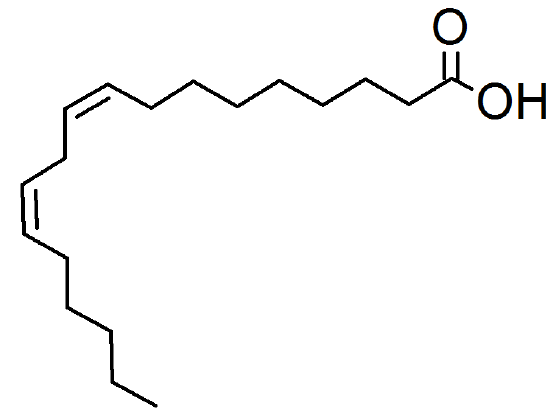15: Lipids (Structure and Function): Questions
- Page ID
- 43929
Energy Storage Lipids: Triglycerides
(01) Recall the term ‘saturated’ from previous chapters. What differs between a saturated fat and an unsaturated fat? What differs between a monounsaturated fat and a polyunsaturated fat?
(02) There are two ways to count on a fatty acid, delta and omega. Using both methods, classify arachidonic acid.

(03) Linoleic acid is an omega-______ acid, as well as a delta-_______ acid.

(04) Arrange the following fatty acids in order from lowest melting point to highest: myristic acid, arachidonic acid, linolenic acid, stearic acid, oleic acid. You can find the structures in our Chem Wiki text or in-class homework activity. What do the highest have in common? What do the lowest have in common?
(05) Triglycerides are so named because of the features they have in common. What is/are the functional groups they have in common? What are the other structures triglycerides have in common?
(06) Fats like lard and butter are solid at room temperature. What is it about the structures of their fatty acids that would support this trend?
(07) If a sample of a lipid contains fatty acids that are 89% saturated, would you expect this lipid to be solid at room temperature or liquid? What if the fatty acids were only 13% saturated?
(08) A simple triglyceride is one that has all three fatty acid chains identical to one another. Sketch a simple triglyceride whose fatty acid chains are composed of linoleic acid.
(09) There are a wide range of oils and fats used in the culinary arts. Arrange the following in order from least saturated to most saturated: corn oil, lard, butter, canola oil, olive oil, coconut oil.
(10) The density of lipids has to do with how tightly they can pack together in a given space. Using what you know of the relative melting points of different fatty acids and intermolecular forces of hydrocarbons, explain whether saturated or unsaturated fats are able to compact together more tightly.
(11) Examine the following two fatty acids. Classify them as cis or trans. Which of the two do you believe would be more densely packed together? Which would have the lower melting point? Explain.

Membrane Lipids: Phosopholipids and Glycolipids
(12) Describe the structure of the lipid bilayer that makes up the cell membrane. What role does the cell membrane play?
(13) How can we differentiate between a glycerophospholipid and a sphingophospholipid?
(14) Examine the membrane lipid pictured below and answer the following questions.

- Is this lipid classified as a phospholipid or a glycolipid? How can you tell?
- Is this lipid considered a sphingolipid or a glycerophospholipid? How can you tell?
- What fatty acid chains are used in this lipid? Are they saturated or unsaturated? What functional group enables them to connect to the backbone?
(15) The bilayer that makes up the cell membrane contains lipids composed of two regions that align in such a way as to keep the opposing regions separated. What are the intermolecular forces that are present in the outer portions of the membrane lipids? What intermolecular forces are utilized by the interior portions of the membrane lipids?
(16) Practice sketching a phospholipid bilayer using a minimum of 10 individual lipids.
(17) The cell membrane is made up of different layers of attractive force, polar and non-polar. Are there any types of molecules that can pass through both layers without assistance or using special passages? Give at least one specific example.
Cholesterol and Other Steroid Hormones
(18) Steroid derivatives like cholesterol are also part of the lipid family. Name three useful by-products that cholesterol can be converted into within the body.
(19) Both fatty acids and steroids (and steroid derivatives) such as cholesterol are part of the lipid family of biomolecules. In what ways are fatty acids and cholesterol similar?
(20) Define and describe the process of emulsification. What compounds are required for this process to take place and what organs are responsible for producing them?
(21) Regulation and control of body functions are major roles of hormones. Give three examples of steroid hormones and what they regulate.
(22) Cholesterol, shown below, is the root of the steroid hormones. Consult the structures of the other examples in your text and, given the following clues, compare them with the structure of cholesterol and determine the identity of each of the following steroid derivatives.

- Completely replaces the carbon chain on the cyclopentane with an alcohol group AND make the original alcohol group into a phenol
- Contains 3 ketone groups that cholesterol does not
- Adds two additional alcohol groups and an acid group to cholesterol
Lipids & Medicine
(23) What role do eicosanoids play in the body? What is the primary fatty acid in their composition?
(24) What purpose does inflammation serve? What are some of the symptoms of inflammation?
(25) Like other enzymes, arachidonic acid can be prevented from working by way of inhibitors. What effect does a lipoxygenase inhibitor have on eicosanoids? What effect does a cyclooxygenase inhibitor have?
(26) Aspirin is an NSAID. What does NSAID stand for? How do NSAIDs work?

